Alongside Sweden and Finland, Norway is particularly popular with wild campers. But motorhome travellers also appreciate the wild nature. The fjords in particular are the epitome of an untouched Nordic camping landscape. However, it is not only the regulations for wild camping that differ from the other Scandinavian countries. Costs, the conditions on campsites and, last but not least, the journey are also points that you need to consider when planning your trip. To give you an overview of what options you have, how much money you should budget and what will make your trip easier, we have put together a comprehensive overview of camping in Norway.
Wild camping in Norway
In Norway, as with camping in Sweden, everyman’s right (in Norwegian “allemannsretten”) applies. This has been enshrined in law since 1957 and regulates the use of the land and nature. This means that anyone can camp wild in the mountains, in the forest and even on private property.
Nevertheless, there are certain rules to protect nature and people. For example, you must keep at least 150 metres away from the nearest house and parked cars and may only pick berries and mushrooms for your own consumption. There may only be special regulations for the rare cloudberry.
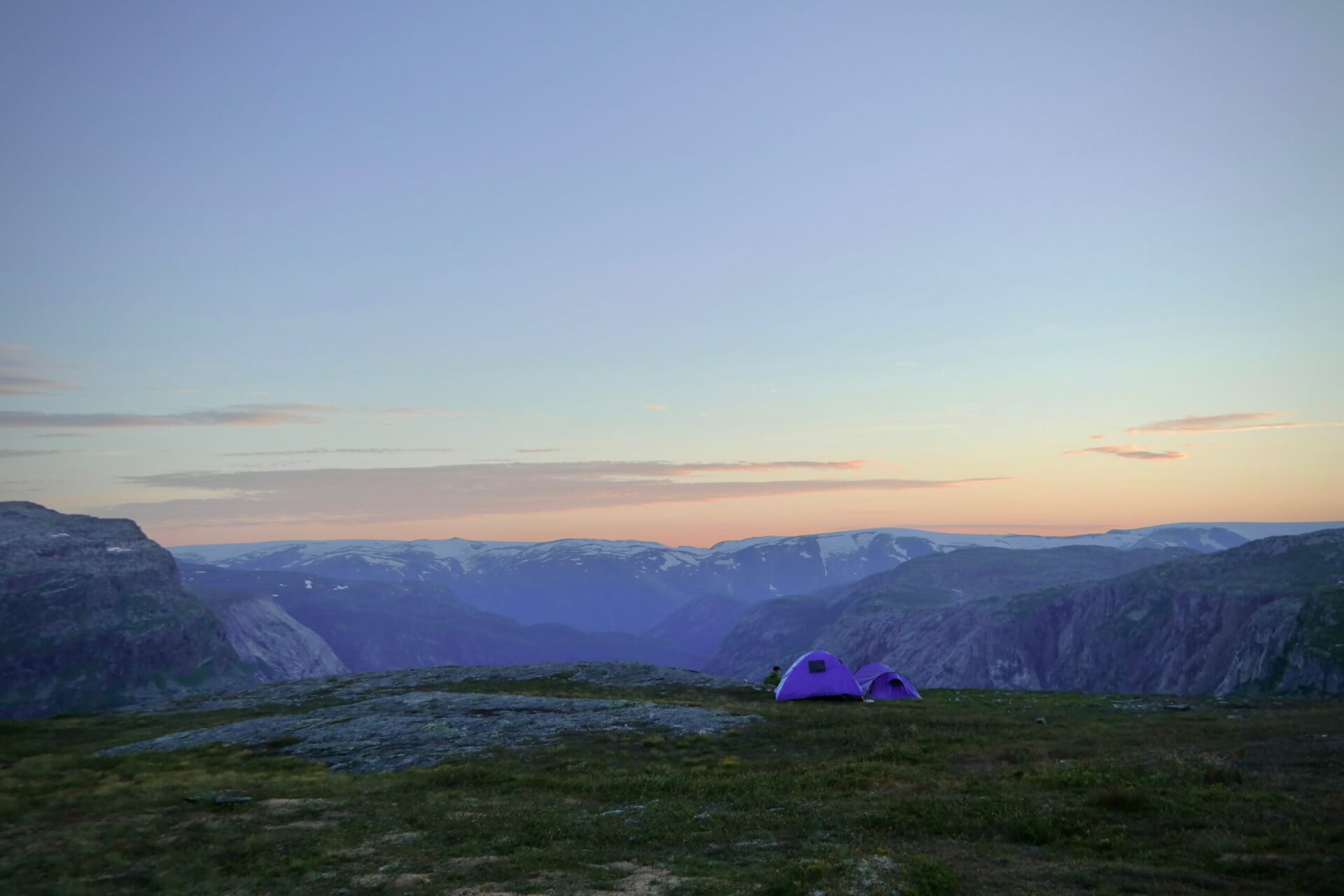
Agricultural land and rest areas are excluded, as well as private land. In addition, you should leave the site as you found it.
From 15 April to 15 September, open fires are prohibited near wooded areas. You should therefore use a camping cooker without an open flame. However, in times of extreme drought, those are prohibited as well. You should strictly adhere to this, as otherwise you could be responsible for a forest fire.
You can find information on the risk of forest fires online. All you need to know is the name of the region and forest you are travelling in and the fire risk will be displayed in green, yellow or orange, so you don’t need to know Norwegian.
When wild camping, you should never forget that you are in the great outdoors. Be prepared and equipped accordingly. If you would like to find out more, take a look at our packing list for wild camping in Sweden.
Camping in Norway with the motorhome
If you don’t want to travel with a tent or rent a cabin, room or similar, you can opt for a motorhome or caravan. The advantages are obvious: you are flexible, can transport your own equipment and always have your own place to sleep with you. Therefore, it is a more comfortable way of camping close to nature.
Is it allowed to stand free with a motorhome in Norway?
No, because the right of public access does not apply to motorised vehicles in Norway either. While you are allowed to move freely on foot, by bike, on skis and in a canoe, for example, and spend the night in the countryside, this does not apply to caravans and motorhomes.
So if you are travelling with a camper, you have to head for a pitch or campsite. Not only are there a lot of them in Norway, but you don’t usually have to miss out on being close to nature. If you want to keep an eye on your budget, you can choose one of the inexpensive pitches that are often available at harbours. However, you should bear in mind that these tend to have basic facilities and can sometimes get a little crowded.
Camping in Norway
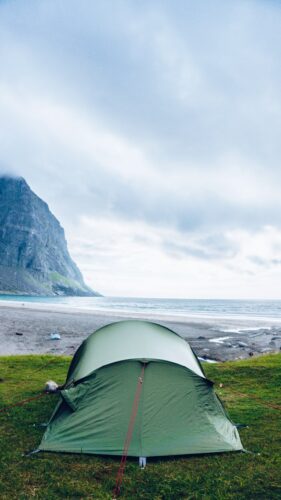
As already mentioned, you can sleep in a tent almost anywhere in the great outdoors in Norway as long as you don’t disturb nature or people. However, as there are no shower or cooking facilities (apart from your own camping cooker), many people opt for a campsite or a hut, at least occasionally.
There you can use the existing infrastructure, especially for washing and showering. Thus, especially on longer trips, it can be very pleasant to sleep in a permanent campsite every few nights.
In the north of Norway in particular, you should have no difficulty finding a pitch spontaneously. In the south or in popular camping regions such as the Lofoten Islands, however, especially during the peak season, you should enquire in advance, about how full the campsite is and whether you should perhaps make a reservation.
Is camping in Norway dangerous?
You don’t have to worry much, when camping in Norway. Especially in the remote regions of northern Norway, it is unlikely that you will even meet people.
However, it goes without saying that you should not necessarily leave your car full of valuables alone in tourist areas or large cities. Even in Norway, cars are broken into from time to time. But do not expect to be robbed at night. Nevertheless, you probably should not pitch your tent within sight of a country road.
What wild animals are there in Norway?
Norway has a few wild predators. These include
- Bear
- Moose
- Wolverine
- Wolf
A reason to stay at home? Absolutely not! The only one of these animals that causes deaths every year is the moose – and that’s due to road accidents. All the other animals on this list are more likely to run away when they hear you coming. And the chances of you actually seeing one of Norway’s 350 bears are really slim!
Camping in Norway: Rent cabins
Whether you want to take a break from your tent on the third rainy day in a row or simply want a firm roof and a soft bed: small rental cabins are perfect for a cosy night.
They can be rented on many campsites and their furnishings range from purist to luxury, depending on your requirements and budget.
Fishing while camping in Norway
If you want to go fishing in Norway, you are not alone. Norway is not only particularly rich in water, but also boasts a particularly large variety of species. In addition, there are perfect conditions at specialised campsites that offer you everything you need to cut up and process your catch.
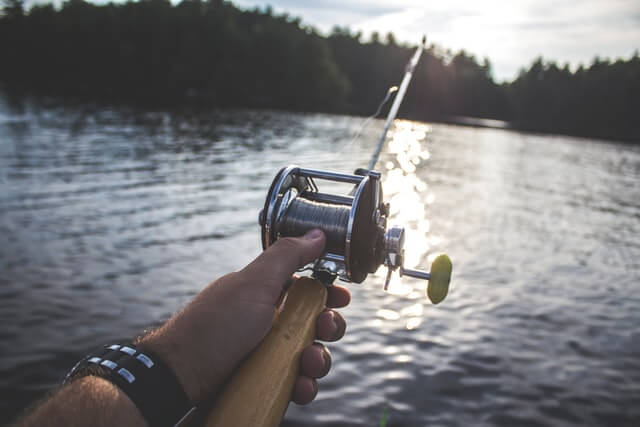
You can buy fishing licences at petrol stations or directly at the campsite, while prices vary depending on the region. How much you are allowed to fish depends on various factors. Find out more about this in our guide to fishing in Norway.
How expensive is camping in Norway?
Many people think that Norway is a particularly expensive country. As far as food and petrol are concerned, this is somewhat true. However, your budget can be greatly influenced by the type of holiday you choose. If you are travelling with your own car and camping in the wild, you will pay significantly less than someone who rents a large camper and stays at five-star campsites every night.
Overall, campsites are no more expensive than the European average. Pitches are on average between 20 and 30 euros (17 – 25 GBP), for tents it can be less. However, you should bear in mind that showers and laundry usually cost extra.
Tolls in Scandinavia
Another point that is often forgotten is the toll. Not only do you have to pay at least 200 euros (~ 171 GBP) for a car with two passengers to cross at least three bridges overland, but tolls are also charged on Norwegian roads. This is rather the exception in Scandinavia.
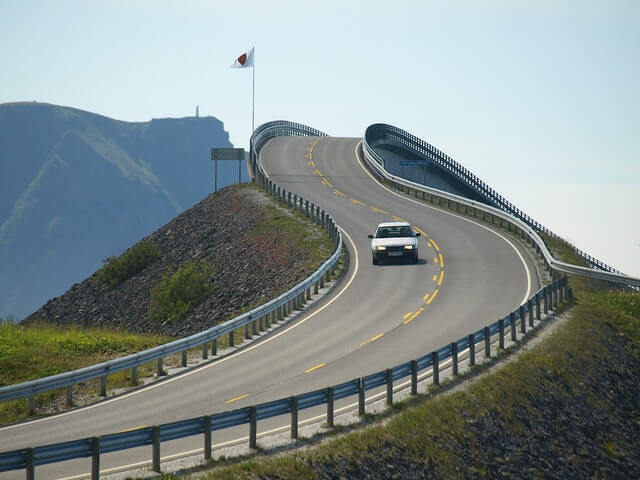
There are many toll roads in Norway, but how much you have to pay depends on the weight of your vehicle. Vehicles under 3.5 tonnes fall under class 1 and anything over that, as well as commercial vehicles fall under class 2, the more expensive class.
Your licence plate number is automatically recorded and the invoice is sent to you. However, you can also set up an account with EPC online, which allows you to view the fees and deadlines at any time.
Food for your trip to Norway: how to stock up?
You should set aside about a third of your usual budget for food shopping if you are self-catering. Restaurants are generally more expensive than in the UK. If you are travelling overland, it can therefore be helpful to buy at least some of your food supplies beforehand.
Camping in Norway: tips for a stress-free holiday
- Be prepared to pay by card.
- We recommend a credit card without a fee for foreign payments.
- If possible, buy some of your groceries beforehand.
- Register online with EPC so that you can view your outstanding toll charges at any time.
- Emergency numbers: you can reach the police on 112 and the fire brigade on 110.
Camping Key Europe for your holiday in Norway
If you mainly want to stay overnight on campsites, you should consider purchasing a Camping Key Europe, which costs approx. 16 euros (~ 13 GBP) for one year and is valid throughout Europe.
The advantages are faster check-in and check-out, as your details are stored centrally on the card, as well as various discounts on selected pitches, accommodation and leisure activities. You are also covered by liability insurance at the campsite.
Travelling to Norway
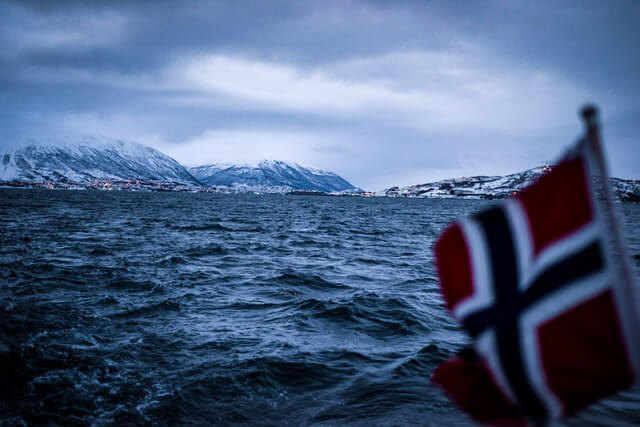
If you want to camp, you can either travel with your own vehicle or hire one on site. With your own vehicle, you have the option of travelling by land or by ferry. The following routes are offered regularly:
- Kiel – Oslo (Color Line, 20 hours)
- Copenhagen – Oslo (DFDS Seaways, 21 hours)
- Fredrikshavn – Oslo (DFDS Seaways, 9.5 hours)
- Hirtshals – Bergen (Fjord Line, from 16.5 hours)
- Hirtshals – Kristiansand (Color Line, from 3.25 hours)
- Hirtshals – Larvik (Color Line, from 3.75 hours)
- Hirtshals – Lagesund (Fjord Line, 4.5 hours)
- Hirtshals – Stavanger (Fjord Line, from 10.5 hours)
As far as the journey is concerned, switching to a ferry can be worthwhile in terms of price, especially if you don’t have that much time to spare. As you can sleep, eat and enjoy the crossing in comfort on the ferry, this is a particularly stress-free and yet beautiful option if you want to travel without your own vehicle. The overland route is beautiful, but also time-consuming.
If you want to hire a vehicle, you can travel by plane, train or bus. The bus is often the cheapest option, but is not particularly comfortable, taking about 24 hours. The plane is of course the fastest, but the least environmentally friendly option. Travelling by train takes about 24 hours as well from London to Oslo, for example.